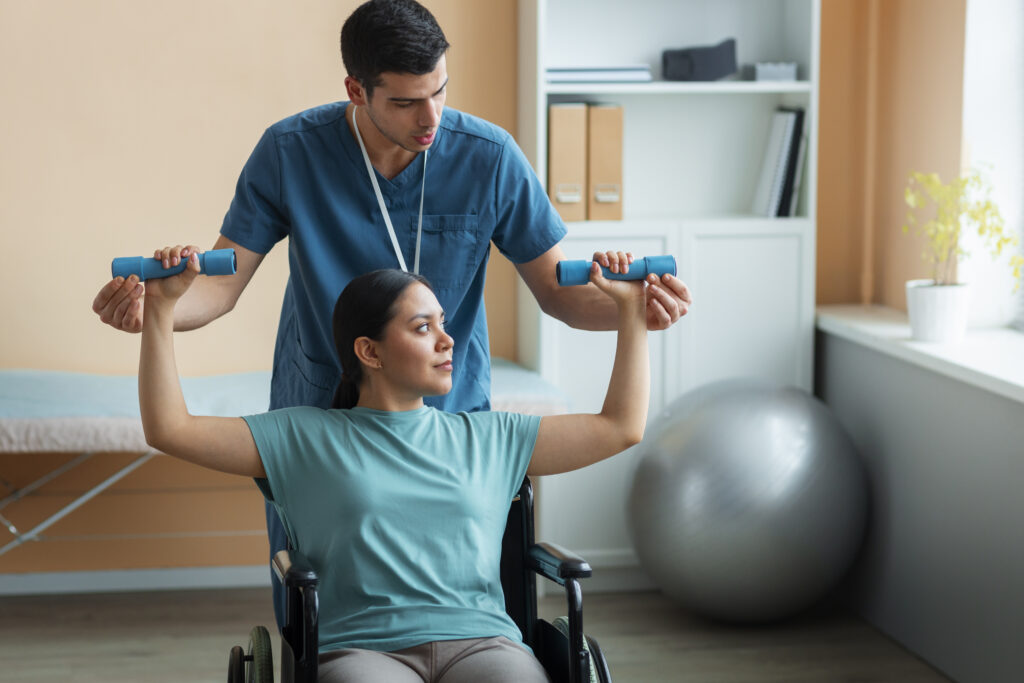Why we did the study: In a prior study (Salisbury et al., Outcomes of Six Specific Types of Post-Hospital Brain Injury Rehabilitation Programs), we found that intensive post-hospital brain injury rehabilitation helped participants make progress toward returning to family and community life after traumatic brain injury (TBI), stroke or other acquired brain injury (other ABI). However, this study was uncontrolled meaning that it did not meet a high scientific standard. In a new study, we compared participants in intensive rehabilitation programs to similar individuals who received different kinds or different levels of care. These types of controls are called quasi-experimental. The most scientifically rigorous experimental control is a double-blind randomized controlled trial. However, it would be unethical to randomly (by chance) decide who gets rehabilitation. Double-blind means that neither the provider nor the participant knows whether they are getting rehabilitation or are involved in some other activity that should not help them improve. That would be impossible in rehabilitation settings!
How are intensive rehabilitation programs different from supported living programs? Intensive rehabilitation involves participants in interdisciplinary rehabilitation therapies (like physical, occupational, and speech therapy) with a goal of helping them improve their functional abilities. Supported living programs help participants sustain the gains they have made previously in rehabilitation and successfully live in the community. These types of programs are described in greater detail elsewhere on the FABR website.
How we did this study: In the prior study, we showed that participants in intensive rehabilitation make more progress than those who are just getting support in supported living programs. However, the people in the supported living programs generally were many more years post-injury than those in intensive rehabilitation, so we found participants in both intensive rehabilitation and supported living programs who were similar in time post-injury, sex, age, and had the same level of disability on the Mayo-Portland Adaptability Inventory (MPAI-4) on their initial evaluation. We were able to identify 228 participants (114 in each group) that matched in these areas. We also looked at whether the amount of rehabilitation affected people’s recovery in a group of 1,344 participants. Did people who received the recommended amount of rehabilitation do better than those who did not or those who received more treatment than recommended? We measured progress using the MPAI-4 which measures basic physical and cognitive abilities, emotional adjustment and interpersonal interactions, and ability to participate in social and other community activities.

What we found: As the figure shows, the group that received intensive rehabilitation made progress over the course of rehabilitation compared to the supported living group who did not change over a similar period of time. The positive change for the intensive rehabilitation participants was great enough that it would be expected to make a real difference in their daily lives. Most of the participants in both types of programs had TBI. We also found that participants with TBI and stroke who received less than the recommended amount of rehabilitation did not make as much progress as those who completed the recommended amount. Participants left rehabilitation early for a variety of reasons, including personal, family, and funding. Those who received more than the recommended amount of rehabilitation did better than those who did not receive the recommended amount but did not do better than those who received the recommended amount of treatment.
Take home points:
-
- This scientifically rigorous, controlled study supports the conclusions of the previous study, that is:
-
- Intensive post-hospital brain injury rehabilitation helps participants make progress in getting back to family and community living.
- Progress is great enough that it can make a real difference in their daily lives and the lives of their families and other people they live with.
-
- This scientifically rigorous, controlled study supports the conclusions of the previous study, that is:
This summary is based on a scientific article published in a peer-reviewed journal. An abstract and the original article can be viewed at: Parrott D, Salisbury DB, Altman IM, Logan DM, McGrath C, Walters GJ, Malec JF. Evaluation of Posthospital Brain Injury Rehabilitation Outcomes With Quasi-Experimental Controls. Journal of Head Trauma Rehabilitation. Epub ahead of print, August 05, 2024.
FABR (Foundation to Advance Brain Rehabilitation) is a one-of-a-kind alliance between leading brain injury rehabilitation organizations from across the United States to improve outcomes in the rehabilitation field. The partnership allows the organization to aggregate outcome data to launch the only know collaborative database in the United States that captures the impact of brain injury rehabilitation following acute care.

